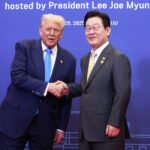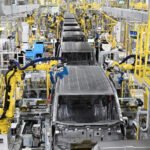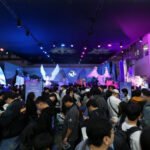
Taekwang Group has joined forces with TPG to acquire K Shipbuilding Co., marking the South Korean conglomerate’s boldest return to major dealmaking in nearly two decades and positioning the consortium as one of the strongest contenders for the rebounding shipyard once known as STX Offshore & Shipbuilding Co.
The chemical-to-textile Korean company submitted a letter of intent on Wednesday in partnership with TPG, the San Francisco–based alternative asset manager formerly known as Texas Pacific Group, according to people familiar with the matter on Thursday.
More than three strategic and financial investors are also said to have joined the preliminary bidding round, sources said.
But the country’s top three shipbuilders – HD Hyundai Heavy Industries Co., Hanwha Ocean Co. and Samsung Heavy Industries Co. – did not join the race.
Up for grabs is a 99.58% stake in the Korean mid-size shipbuilder owned by a consortium led by Seoul-based KHI Investment and UAMCO, along with roughly 170 billion won ($116.2 million) in debts.
The deal, including management control, is expected to fetch around 500 billion won.

Samil PwC, which won the sell-side mandate earlier this year, is managing the auction.
It plans to accept more letters of intent if additional bidders come forward.
Current bidders will be given about two months of due diligence ahead of a binding auction slated for January.
TAEKWANG’S RETURN TO AGGRESSIVE M&A ACTIVITY
Market participants view the Taekwang-TPG consortium as one of the frontrunners.
Taekwang has revived its M&A activities this year for the first time since 2008, signing a deal last month to acquire Aekyung Industrial Co. and joining its insurance affiliate Heungkuk Life Insurance Co. in a bidding for IGIS Asset Management Co., the country’s largest real-estate investment firm.
Armed with 2.8 trillion won in liquid assets, the group has pledged to invest 1.5 trillion won through 2026 in new businesses, including consumer, real estate and energy ventures, as part of efforts to reduce reliance on its cyclical chemicals business while capitalizing on global demand trends.
A RARE ASSET BACK IN PLAY

K Shipbuilding has become one of the most closely watched industrial assets in Korea’s M&A market this year.
Once crippled by losses after the 2008 global financial crisis, the mid-sized shipbuilder has staged a sharp turnaround amid a global shipbuilding upswing and rising defense and maintenance-related demand, one of the key reasons behind Taekwang’s bet.
A major driver of K Shipbuilding’s revival has been its strategic pivot into small and mid-size tankers, a niche market largely neglected by Korea’s largest shipbuilders as they focus on high-value, eco-friendly vessels.
By concentrating on this segment, K Shipbuilding has emerged as a global leader, capturing a 19.1% share of the 74,000-ton tanker market, the highest in the world.
The company has also sharpened its technological edge.
In July, it became the first globally to develop a 50,000-ton class dual-fuel tanker capable of running on both LNG and diesel, a milestone that analysts say puts it ahead of Chinese competitors in key engineering capabilities.
These moves have allowed K Shipbuilding to ride the “supercycle” now sweeping Korea’s mid-tier shipyards.

With HD Hyundai Heavy, Samsung Heavy and Hanwha Ocean concentrating their capacity on environmentally friendly next-generation ships, lower-priced tanker orders have increasingly flowed to mid-sized players, like K Shipbuilding.
At the same time, US restrictions on Chinese shipbuilders have created an extended period of stable order inflows for Korean shipyards.
The financial turnaround has been swift.
Through the third quarter, the company generated 84.7 billion won in operating profit, more than five times its year-ago level, while revenue climbed 27.2% to 899.7 billion won.
Including fourth-quarter performance, analysts expect full-year operating profit to surpass 100 billion won for the first time since 2012.
For Taekwang, whose chemicals and textile businesses have struggled with prolonged weakness, the bid underscores the group’s re-emergence as an active buyer seeking long-term growth engines.
A STRATEGIC ASSET WITH MRO UPSIDE

Its appeal has also widened beyond domestic strategic buyers to include US private-equity firms, drawn by the company’s recovery trajectory and its significant, yet untapped, potential in naval maintenance, repair and overhaul (MRO) services.
That segment is becoming increasingly important under the so-called “Make American Shipbuilding Great Again” (MASGA) initiative for US-Korea cooperation on naval and commercial shipbuilding.
Industry officials say K Shipbuilding is well-positioned to become one of the program’s Asian partners.
The shipyard has already begun moving in that direction. At its Jinhae yard, it is building facilities capable of servicing six naval vessels a year, effectively marking its entry into MASGA-linked MRO work.
It plans to invest an additional 200 billion won to expand capacity to 32 vessels annually, a scale that could make it one of the largest MRO hubs for allied fleets in Northeast Asia.
The Jinhae shipyard’s geography is also a strategic asset.
The yard is located roughly six kilometers from the Jinhae naval base, home to the US Navy’s Seventh Fleet logistics support unit, giving K Shipbuilding a proximity advantage for future maintenance contracts on US naval vessels.

The combination of location, expansion plans and the broader MASGA framework has intensified foreign interest, like TPG.
Carlyle and Blackstone reviewed the deal earlier this year, though neither submitted bids; both could still return for the main round, potentially in partnership with a Korean strategic investor.
NEXT STEPS IN AUCTION
The sellers – UAMCO, a bad-asset manager backed by major Korean banks, and KHI Investment – are expected to weigh not only price but also operational capabilities, given the shipyard’s strategic nature and expansion prospects in defense-related services.
Founded in 1967 as Dongyang Shipbuilding and acquired by STX in 2001, the shipyard enjoyed a brief stint as the world’s fourth largest by order backlog.
The 2008 global financial crisis triggered a prolonged decline, culminating in court receivership and a sale to the KHI–UAMCO consortium in 2021.
With the shipyard now profitable and running at more than 110% utilization, they are seeking to realize gains amid a broader shipbuilding recovery.
The asking price is around 500 billion won, based on a price-to-book multiple of 1.2 to 1.5 times – a discount, industry watchers say, compared with peers such as Daehan Shipbuilding Co., which was priced using a PBR of 4.58.















